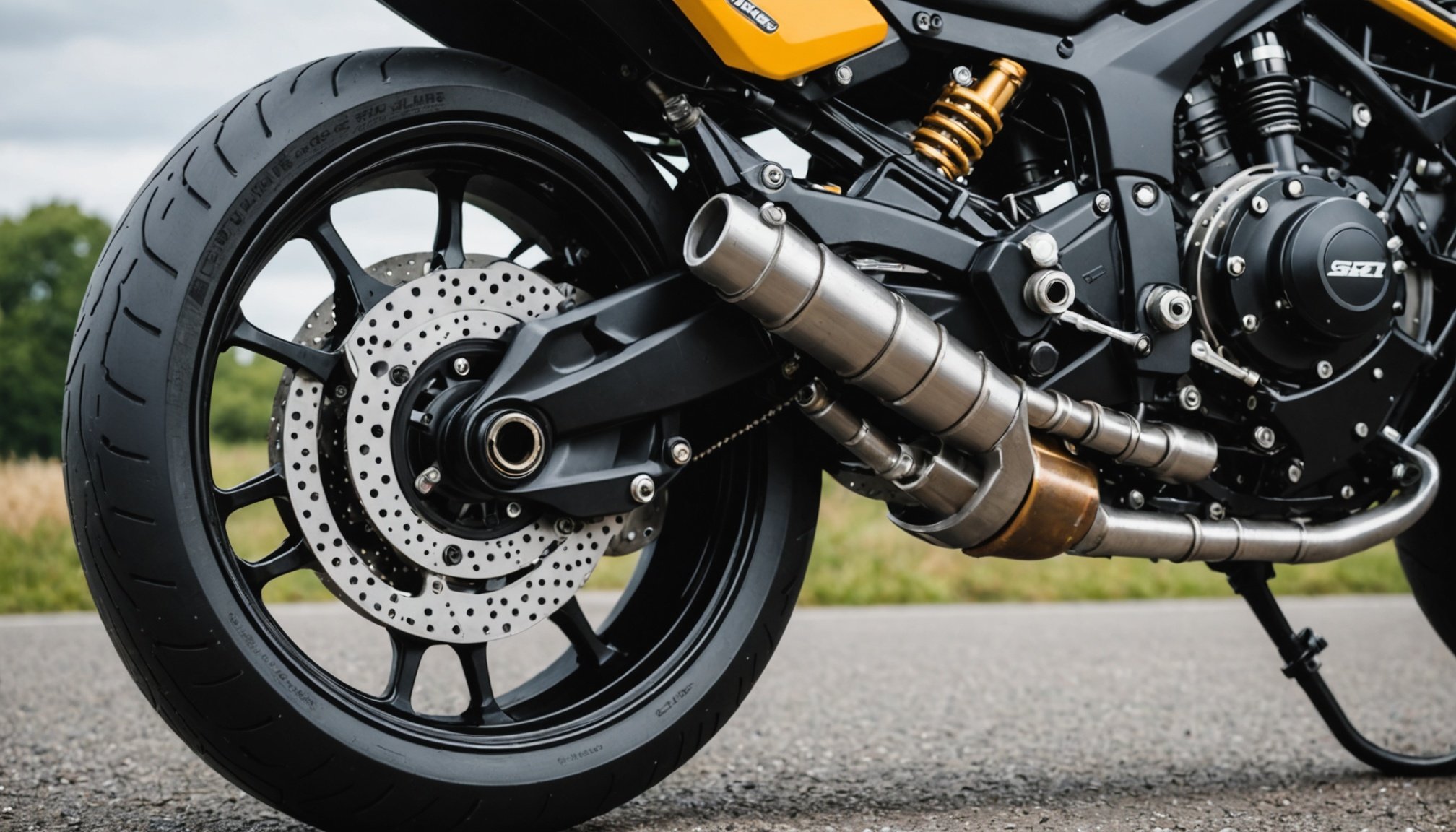Understanding Rear Suspension Basics
Rear suspension systems play a crucial role in the dynamics of a sport bike’s performance. They are integral to maintaining traction and handling, ensuring that riders can confidently navigate various terrains. The rear suspension mechanically connects the frame to the wheels and absorbs shock from road irregularities, thus providing stability.
Several types of suspension systems are commonly found in sport bikes. Notably, mono-shock systems, which utilize a single shock absorber that often includes linkage, offer a precision response that enhances handling. Dual-shock systems, while less common in modern sport bikes, are still in use today, offering simplicity and ease of maintenance.
Also to see : Mastering the guidelines: a comprehensive guide to uk laws for riding sport bikes in bus lanes
The importance of rear suspension systems extends beyond comfort. In fact, they are vital to optimizing the interaction between the tyre and the road. By properly absorbing and managing impacts, these systems enhance grip, reducing the likelihood of wheel slip during acceleration or braking. This is particularly significant for sport bikes, which are often used in high-speed environments where precision handling is paramount.
Understanding rear suspension setups can provide clearer insights into customisation options that improve performance and adapt to specific sport bike dynamics. As a result, riders can fine-tune solutions that suit their individual riding style and local road conditions.
This might interest you : Unveiling how different sport bike tires influence handling in the uk”s wet weather
Analyzing the UK Road Conditions
Understanding UK road conditions is essential for sport bike enthusiasts aiming to optimise their rear suspension settings. The bumpy roads often found across the UK present unique riding challenges. These conditions can vary significantly, from smooth, freshly paved surfaces to uneven, patched-up pathways that test a rider’s skill and bike dynamics.
Navigating such diverse terrains demands more than just rider expertise; it calls for a finely tuned suspension system. The impact on riding yields a necessity for adjustments tailored to these conditions. Proper suspension tuning allows for better absorption of road irregularities, offering improved comfort and control. In fact, suitable suspension settings significantly enhance traction and considerably reduce fatigue during rides.
Moreover, the challenges posed by these uneven road surfaces underscore the importance of understanding suspension tuning. Riders often find that stock configurations don’t accommodate the dynamic needs of UK riding conditions. Thus, adjusting the suspension parameters, such as damping and spring rates, plays a critical role.
For those keen on adventure and daily commuting alike, acknowledging these conditions and adapting suspension settings can transform the riding experience. Embracing these riding challenges will result in a smoother performance tailored for all UK terrains.
Key Rear Suspension Components
In the realm of sport bike dynamics, understanding suspension components is pivotal. A sport bike’s rear suspension comprises integral parts, such as shock absorbers and linkage systems, each contributing uniquely to performance and comfort.
Shock Absorbers
Shock absorbers are the backbone of any rear suspension system. They play a substantial role in dissipating energy from road impacts, ensuring that the tyres remain in contact with the road surface during dynamic manoeuvres. High-quality shock absorbers are crucial for enhancing comfort, maintaining traction, and improving overall control of the bike. Without effective shock absorbers, riders may encounter a harsher ride and diminished precision.
Linkage Systems
Linkage systems, often found in advanced suspension setups, serve a significant role in optimizing handling and responsiveness. By effectively transferring forces from the shock absorber to the frame, these systems can smooth out road irregularities, lending to a more balanced ride. The design and quality of linkage systems directly impact how a bike handles, affecting both agility and stability.
Recognising the importance of these components, riders can make informed choices when customising or upgrading their bikes, effectively improving their sport bike’s dynamics for varied riding conditions.
Suspension Adjustment Techniques
Fine-tuning your sport bike’s rear suspension is essential for optimizing your riding experience, especially with diverse road conditions. One critical aspect is the adjustment of the ride height, a factor that impacts both handling and comfort. Adjusting this properly can improve stability during cornering and enhance overall responsiveness.
Step-by-step Adjustment Guide
- Start with measuring the sag: Use a tape measure to gauge the sag – the bike’s own weight depressing the springs – this helps determine spring pre-load.
- Adjust compression settings: Focus on how your bike handles bumps. Harder settings are suited for smoother roads, whereas softer ones accommodate uneven surfaces.
- Dial in damping settings: This manages the speed of shock absorption. Ideal settings balance between too fast (and potentially jarring) and too slow (resulting in sluggish handling).
Factors to Consider
The rider’s weight and style significantly influence how these settings should be tweaked. For lighter riders, less compression and pre-load are generally favored, while heavier riders might opt for stiffer setups. Always ensure that adjustments suit the specific demands of the terrain you frequently traverse.
Prioritizing these steps enhances the traction and handling of your sport bike, aligning it with your unique requirements and the UK’s dynamic road conditions.
Recommended Modifications for Improved Traction
Exploring suspension modifications is key to enhancing your sport bike’s performance, especially against the backdrop of the UK’s challenging road conditions. Diving into aftermarket products can significantly elevate traction and handling.
Upgrading to high-performance shock absorbers is one effective way to improve your sport bike’s dynamics. These absorbers are specifically designed to respond faster to road irregularities, ensuring that tyres maintain optimal contact with various surfaces. High-performance absorbers are also made from superior materials, providing durability and responsiveness.
Custom modifications can further enhance your bike’s ability to tackle bumpy roads found across the UK. Adjusting spring rates and damping settings tailored to the local environment is vital. Such modifications help in fine-tuning the suspension to accommodate different terrains, allowing for a smoother ride and better control.
-
Aftermarket springs: Often provide a firmer setup suited for aggressive riding.
-
Linkage enhancements: Improve how forces are transmitted through the suspension, leading to better stability.
Considering these upgrades not only boosts your sport bike’s traction but also personalises its performance to fit your riding style. By addressing specific conditions, these modifications pave the way for a more refined riding experience, allowing riders to appreciate both everyday commutes and adventurous trips.
Practical Tips for Everyday Riding
For the sport bike enthusiast, maintaining your bike’s rear suspension is vital for optimum performance and safety. Consistent suspension maintenance ensures that your bike can handle varying road conditions with ease. Riders should regularly check for any signs of wear or damage to the shock absorbers and linkage systems, as these components are essential for smooth operations.
On-the-fly suspension adjustments can notably enhance your riding experience. If you find yourself on a particularly bumpy road, consider softening the ride by reducing the pre-load or adjusting the damping settings to better accommodate the terrain. Conversely, for smoother tracks, a firmer setup typically offers improved handling and stability.
Real-world application of these adjustments can vastly vary. Many sport bike riders in the UK report noticeable improvements in comfort and control when adapting their setup to local road conditions. For instance, increasing the damping rate in urban areas with less forgiving surfaces can significantly reduce vibrations, offering a more comfortable ride.
Ultimately, individual riding styles and preferences will dictate the exact settings. However, remaining attuned to your sport bike’s performance and adjusting as needed can make everyday rides more enjoyable and less strenuous.
Expert Insights and User Testimonials
Understanding expert advice on suspension tuning is crucial for optimizing your sport bike dynamics. Industry professionals recommend regular shock absorber checks and accurate adjustment of damping settings to suit different terrains. These adjustments ensure that the bike maintains proper alignment with road surfaces, enhancing both traction and safety.
User feedback often highlights tangible improvements after adopting expert-recommended tuning methods. Riders report a noticeable increase in comfort and control when tweaking suspension settings for specific road conditions, like the varied UK road surfaces. For instance, reducing spring pre-load and adjusting damping for softer settings can significantly improve ride quality on bumpy roads.
Testimonials further reflect diverse preferences among riders. Some prefer a stiffer suspension for more aggressive riding styles, while others opt for softer setups for comfort during long commutes. This diversity underscores the importance of personalising suspension modifications to individual needs.
- Robust damping adjustments: Vital for absorbing shocks from uneven terrains.
- Custom pre-load settings: Important for altering the ride feel and response.
- Consistent maintenance: Key to retaining optimal performance across various conditions.
By integrating expert insights and user experiences, riders can confidently fine-tune their bikes to achieve optimal suspension performance and satisfaction.
FAQs
When it comes to rear suspension FAQs, common questions often revolve around setup and troubleshooting. How can I improve the bike’s handling and traction? A precise rear suspension setup is key. By fine-tuning shock absorbers, you can ensure better road contact, enhancing both traction and control over bumpy surfaces.
Is it essential to adjust the suspension for different riding conditions? Yes, adjusting suspension settings like pre-load and damping according to terrain conditions optimises performance. For instance, softer settings are preferable for bumpy roads, while stiffer setups benefit smoother tracks.
What are misconceptions about suspension modifications? A prevalent myth is that only factory settings ensure performance. Instead, custom sport bike dynamics adjustments tailored to individual preferences lead to significant improvements. Different bikes respond uniquely, so explore options beyond manufacturer defaults.
How to troubleshoot suspension issues? Regular inspections of suspension components for wear and tear can prevent problems. If unusual noises occur, checking the linkage systems often reveals misalignments or worn parts needing attention.
Maintaining an inquiry-based approach and understanding these components will empower riders to confidently navigate their sport bike’s suspension challenges.
















